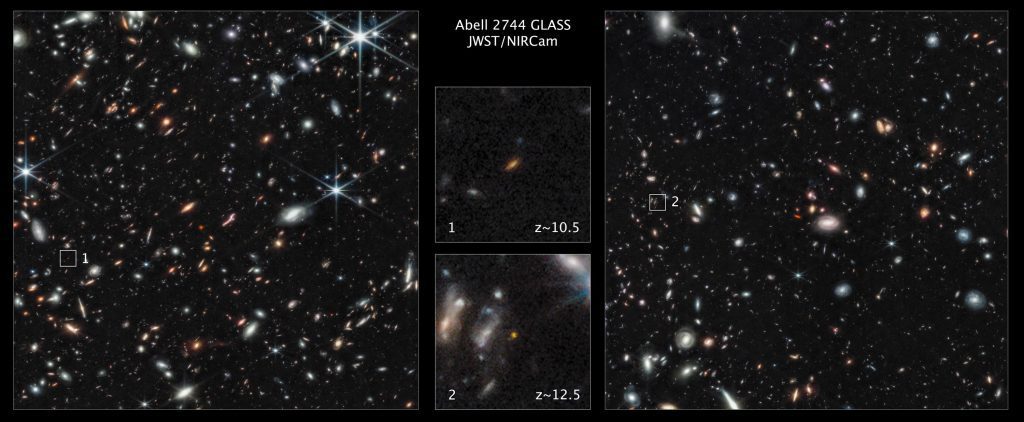
CAPE CANAVERAL, Fla. (AP) — NASA’s Webb Space Telescope has detected bright, early galaxies hitherto hidden from view, including galaxies that may have formed just 350 million years after the cosmic Big Bang.
If the results are verified, astronomers said Thursday, this newly discovered group of stars will surpass the most distant galaxy identified by the Hubble Space Telescope, the record-holder that formed 400 million years after the beginning of the universe.
It was launched last December to succeed the Hubble Telescopethe Webb telescope indicates that stars may have formed sooner than previously thought – perhaps within 2 million years of creation.
Webb’s latest discoveries are detailed in Astrophysical Journal Letters by an international team led by Rohan Naidu of the Harvard-Smithsonian Center for Astrophysics. The article describes two exceptionally bright galaxies, the first believed to have formed 350 million years after the Big Bang and another 450 million years after it.
Naidoo said more infrared observations by Webb were needed before he could claim the new distance record holder.
Although some researchers have reported that they have discovered galaxies closer to the creation of the universe 13.8 billion years ago, these candidates have not yet been verified, as scientists confirmed at a NASA press conference. They indicated that some of them may be later galaxies that mimic earlier galaxies.
“This is a very dynamic time,” said Garth Illingworth of the University of California, Santa Cruz, a co-author of the article published Thursday. “There’s been a lot of first announcements about older galaxies, and we’re still trying to sort out as a community which ones are likely to be real.”
The evidence presented so far is “strong as it gets” for the galaxy, which is believed to have formed 350 million years after the Big Bang, said Tommaso Treu of UCLA, senior scientist for Webb’s Early Science Release program.
If the results are verified and there are more early galaxies, Naidoo and his team write that Webb “will prove very successful in pushing the cosmic frontier to the brink of the Big Bang.”
“When and how the first galaxies formed remains one of the most intriguing questions,” they said in their paper.
These galaxies “were hiding under the limits of what Hubble could do,” noted NASA’s Jane Rigby, a project scientist with Webb.
“They were there waiting for us,” she told reporters. “So it’s a happy surprise that there are so many of these galaxies to study.”
The $10 billion observatory – the world’s largest and most powerful telescope ever sent into space – is in solar orbit a million miles (1.6 million kilometers) from Earth. Full science operations began over the summer, and NASA has since released a series of dazzling snapshots of the universe.
___
The Associated Press Health and Science section receives support from the Howard Hughes Medical Institute’s Division of Science Education. AP is solely responsible for all content.




More Stories
Boeing May Not Be Able to Operate Starliner Before Space Station Is Destroyed
Prehistoric sea cow eaten by crocodile and shark, fossils say
UNC student to become youngest woman to cross space on Blue Origin